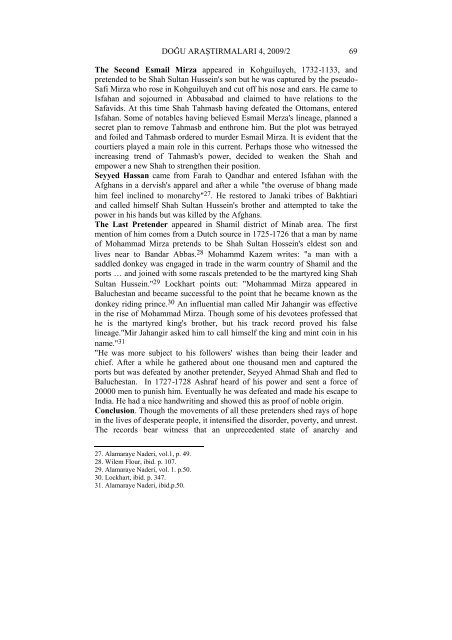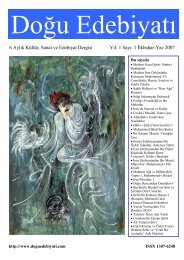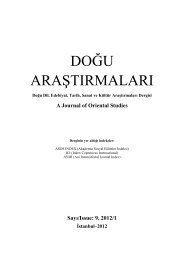A Journal of Oriental Studies Sayı/Issue - Doğu Edebiyatı
A Journal of Oriental Studies Sayı/Issue - Doğu Edebiyatı
A Journal of Oriental Studies Sayı/Issue - Doğu Edebiyatı
You also want an ePaper? Increase the reach of your titles
YUMPU automatically turns print PDFs into web optimized ePapers that Google loves.
DOĞU ARAŞTIRMALARI 4, 2009/2 69<br />
The Second Esmail Mirza appeared in Kohguiluyeh, 1732-1133, and<br />
pretended to be Shah Sultan Hussein's son but he was captured by the pseudo-<br />
Safi Mirza who rose in Kohguiluyeh and cut <strong>of</strong>f his nose and ears. He came to<br />
Isfahan and sojourned in Abbasabad and claimed to have relations to the<br />
Safavids. At this time Shah Tahmasb having defeated the Ottomans, entered<br />
Isfahan. Some <strong>of</strong> notables having believed Esmail Merza's lineage, planned a<br />
secret plan to remove Tahmasb and enthrone him. But the plot was betrayed<br />
and foiled and Tahmasb ordered to murder Esmail Mirza. It is evident that the<br />
courtiers played a main role in this current. Perhaps those who witnessed the<br />
increasing trend <strong>of</strong> Tahmasb's power, decided to weaken the Shah and<br />
empower a new Shah to strengthen their position.<br />
Seyyed Hassan came from Farah to Qandhar and entered Isfahan with the<br />
Afghans in a dervish's apparel and after a while "the overuse <strong>of</strong> bhang made<br />
him feel inclined to monarchy" 27 . He restored to Janaki tribes <strong>of</strong> Bakhtiari<br />
and called himself Shah Sultan Hussein's brother and attempted to take the<br />
power in his hands but was killed by the Afghans.<br />
The Last Pretender appeared in Shamil district <strong>of</strong> Minab area. The first<br />
mention <strong>of</strong> him comes from a Dutch source in 1725-1726 that a man by name<br />
<strong>of</strong> Mohammad Mirza pretends to be Shah Sultan Hossein's eldest son and<br />
lives near to Bandar Abbas. 28 Mohammd Kazem writes: "a man with a<br />
saddled donkey was engaged in trade in the warm country <strong>of</strong> Shamil and the<br />
ports … and joined with some rascals pretended to be the martyred king Shah<br />
Sultan Hussein." 29 Lockhart points out: "Mohammad Mirza appeared in<br />
Baluchestan and became successful to the point that he became known as the<br />
donkey riding prince. 30 An influential man called Mir Jahangir was effective<br />
in the rise <strong>of</strong> Mohammad Mirza. Though some <strong>of</strong> his devotees pr<strong>of</strong>essed that<br />
he is the martyred king's brother, but his track record proved his false<br />
lineage."Mir Jahangir asked him to call himself the king and mint coin in his<br />
name." 31<br />
"He was more subject to his followers' wishes than being their leader and<br />
chief. After a while he gathered about one thousand men and captured the<br />
ports but was defeated by another pretender, Seyyed Ahmad Shah and fled to<br />
Baluchestan. In 1727-1728 Ashraf heard <strong>of</strong> his power and sent a force <strong>of</strong><br />
20000 men to punish him. Eventually he was defeated and made his escape to<br />
India. He had a nice handwriting and showed this as pro<strong>of</strong> <strong>of</strong> noble origin.<br />
Conclusion. Though the movements <strong>of</strong> all these pretenders shed rays <strong>of</strong> hope<br />
in the lives <strong>of</strong> desperate people, it intensified the disorder, poverty, and unrest.<br />
The records bear witness that an unprecedented state <strong>of</strong> anarchy and<br />
27. Alamaraye Naderi, vol.1, p. 49.<br />
28. Wilem Flour, ibid. p. 107.<br />
29. Alamaraye Naderi, vol. 1. p.50.<br />
30. Lockhart, ibid. p. 347.<br />
31. Alamaraye Naderi, ibid.p.50.





